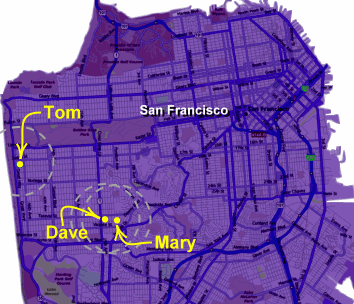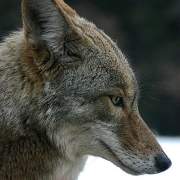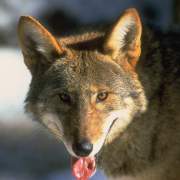It is an unfortunate quirk of our language that the word species, like many similar words, has two different meanings: an absolute one, referring to membership in a named set of items, and a relative one, referring to the relationship between two individual items, independent of naming. This is mostly a problem when used within an expression like "A and B are the same species." Sometimes the differences are subtle, but sometimes they are profound -- the problem is much greater if the individuals in question lived during different time periods. I believe this ambiguity contributes to a huge amount of confusion among those who struggle to grasp evolution, and that many concepts can become much clearer with a simple change of terminology.
I suggest that we avoid the confusion altogether: instead of saying "A and B are the same species," we can say "A and B are interfertile." Interfertile is always a relative term, and thus appropriate for explaining evolution.
Before delving into the differences between absolute and relative (and the logical errors that result from mixing the two meanings), let me go ahead and define interfertile, in the most concise way I possibly can. Note that I have restricted the discussion to animals, but it can apply to other organisms as well, as long as they sexually reproduce.
| interfertile: two animals are interfertile if they would be able to produce an offspring, if they were allowed to mate or were artificially inseminated. If they are both the same sex, they are interfertile if each could produce an offspring with the appropriate sex parent of the other. |
Of course, a key phrase is "if they were allowed to mate or were artificially inseminated." What if one animal lived a thousand years prior to another? What if they lived thousands of miles apart, in the distant past when humans weren't around to transport them around and test it? The simple answer is: "it's hypothetical." If it helps to visualize scientists travelling around in a time machine and collecting sperm and using it to artificially inseminate animals of different time periods, well, do what you have to do.
Note that in some cases interfertile differs somewhat from our usage of the expression same species: for instance, a coyote is a not considered the same species as a gray wolf, and yet it is interfertile with the wolf. This difference should not be a problem, and in almost all cases of discussion of evolution, interfertile will be the better choice: it will be more concise, less ambiguous and less subject to arbitrary human decisions. Also, you'll notice the definition I provided does not have the qualification that the offspring be fertile, as that would introduce a whole new set of ambiguities. (fertile meaning it can reproduce with any existing animal? or any hypothetical animal? does its offspring have to be fertile as well?)

|
| Who lives in Dave's neighborhood: Tom or Mary? |
Absolute vs. relative: it's all about the transitive property
Consider the word neighborhood, another word with both absolute and relative meanings. With the absolute meaning, there are a fixed number of discrete neighborhoods in a city, each of which has a name, and every person lives in exactly one neighborhood. In this sense the word is equivalent to words like county, state and country. Thus, the transitive property will apply: if A lives in the same neighborhood as B, and B lives in the same neighborhood as C, then A must live in the same neighborhood as C.
Meanwhile the relative meaning simply indicates "the area close to a given location." It is roughly equivalent to saying "part of town" or the colloquial "neck of the woods." With the relative term, there are essentially an infinite number of neighborhoods, and they overlap one another. Importantly, the transitive property does not apply: just because A and B are in the same neighborhood, and B and C are in the same neighborhood, we cannot assume that A and C are in the same neighborhood. The more "degrees of separation," the less likely it is for them to be in the same neighborhood.
If we need a non-ambiguous way of saying that Dave and Mary live within a close walk of one another, we are in luck: we can simply say "Dave and Mary are neighbors." Problem solved: "neighbor" is always a relative term.
With the term species, the same situation applies. When speaking only of currently living organisms, the differences between the two meanings of "same species" can be subtle, and don't usually lead to confusion (ring species being a notable exception: see sidebar). But when talking about evolution, we often need to discuss the relationships between organisms that are separated by time: for instance, a present day animal and its ancestor that lived hundreds of thousands of years ago. Here the difference between the two meanings of the term becomes critically important. If we need a non-ambiguous, always relative term to indicate "same-species degree of relatedness" between two organisms, interfertile is probably the best one we've got.

| |
|
Ring species These salamanders in California are all classified as the same taxonomic species. There is a continuous ring of interfertile pairs surrounding the arid Central Valley, but where they meet at the southern end of the valley, it would seem that there are two separate species: two populations, whose members are too distantly related for interbreeding to occur between them. If all the northern salamanders died off, the salamanders would have to be classified as two species. Cases like these show that even when only speaking of currently living populations, the concept of species can occasionally break down. When discussing animals that live at different time periods, this problem becomes the rule rather than the exception.
(illustration inspired by one at pbs.org) | |
The absolute definition of species (where there are a fixed number of taxonomic species, each organism belonging to exactly one) can be convenient for categorization, but it generally fails for explaining the logic of evolution. It really doesn't map directly to the real world, just as named neighborhoods with hard boundaries don't tend to accurately describe real properties of cities.
Trying to interpret the expression "same species" in its absolute meaning, when the relative meaning is the appropriate one, can lead to worlds of confusion and apparent logical contradictions. Remember that with an absolute definition, the transitive property will apply: if organism A is the same species as organism B, and B is the same species as C, then A must be the same species as C. Now combine that with the "obviously true" fact that an organism must always be the same species as its parents, and it becomes easy to see how someone would find evolution to not make logical sense. We get questions like "why has no one has ever observed one animal giving birth to an animal of another species?" The problem, of course, is that they are basing their logic on two different meanings of the word species.
If someone insists on using the absolute definition, they should use it consistantly, and accept that a parent can be a different taxonomic species from its offspring -- just as someone can be in a different named neighborhood than someone who is 20 feet away. But a better solution is to simply stick with the relative meaning, or better yet, use the word interfertile, when trying to explain or understand the logic of evolution.
Typical questions from people confused about the concept of species
The following questions and complaints come from people with a profound misunderstanding of the concept of species (and speciation), much of which can be addressed by clarifying the difference between absolute and relative meanings. In each case, it is clear there is a view of species that is closer to the absolute meaning, that a species represents a single "kind" or "type," and has hard edges, like the hard edged neighborhoods drawn on the map above. These questions and complaints have all been addressed by others, and yet people still struggle with them. In the near future I will a write short article addressing each of them, using the concept of interfertilility rather than that of species.
- If humans evolved from monkeys, why are there still monkeys? (first draft, still needs graphics)
- If one species can evolve from another, we should have seen an animal give birth to an animal of a different species
- Who does the first animal of a new species mate with?
- We've never seen a transitional species
- Micro-evolution (adaptation, change within a "type") might be possible, but there is no evidence of macro-evolution (changing of a "type" to a new "type")
Tips for those teaching / explaining / debating evolution:
- Refer people to this web page, and make sure they understand the difference between absolute and relative, concentrating first on neighborhoods (a subject with less complexities and emotional baggage than biology).
- Avoid the term species whenever possible. Rather than saying "A and B are the same species," say "A and B are genetically similar enough to successfully interbreed if given a chance." Or, of course, you may simply shorten it to "A and B are interfertile." Again, refer them to this page to see a concise definition of interfertile.
- When someone who is questioning evolution uses the term species, ask which meaning they are using, or simply ask them to use a more logically concise way of expressing what they mean, such as the word interfertile.
- Remind people that while humans have a tendency to categorize things and assign words to them, these often arbitrary decisions cannot be used to support any assertion about the things they refer to. For instance, no scientist would attempt to support a hypothesis concerning Pluto based on whether or not humans have chosen to categorize it as a planet.
- If something that seems obvious and intuitive to you seems to confuse someone else, chalk this up to "variation within a population" rather than malice or stupidity. Have patience. Some people prefer clear delineation between types, and just aren't comfortable with shades of gray and blurry boundaries. There are many advantages to their way of viewing things as well (they might make good librarians or politicians, for instance), but it just doesn't work well for understanding evolution.
Email me if you have any thoughts to share.
Thanks for reading,
-rob
P.S. please check out my Firefox extension / bookmarklet, Aardvark



